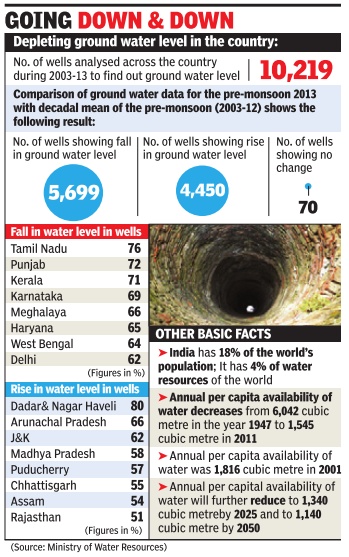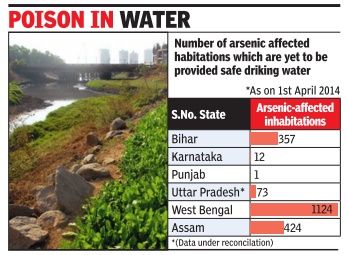Groundwater: India
(→The extent of the problem, state-wise) |
(→Delhi, Rajasthan, Haryana: extraction rises) |
||
| Line 93: | Line 93: | ||
==Delhi, Rajasthan, Haryana: extraction rises== | ==Delhi, Rajasthan, Haryana: extraction rises== | ||
[http://epaperbeta.timesofindia.com/Article.aspx?eid=31808&articlexml=DRY-run-Delhi-Raj-Haryana-going-the-Latur-17042016015041 ''The Times of India''], Apr 17 2016 | [http://epaperbeta.timesofindia.com/Article.aspx?eid=31808&articlexml=DRY-run-Delhi-Raj-Haryana-going-the-Latur-17042016015041 ''The Times of India''], Apr 17 2016 | ||
| + | [[File: Annual per capita availability of water, 1947-2050 (estimated).jpg|Annual per capita availability of water, 1947-2050 (estimated); Graphic courtesy: [http://epaperbeta.timesofindia.com/Article.aspx?eid=31808&articlexml=DRY-run-Delhi-Raj-Haryana-going-the-Latur-17042016015041 ''The Times of India''], Apr 17 2016|frame|500px]] | ||
Vishwa Mohan | Vishwa Mohan | ||
| − | + | '''Delhi, Rajasthan, Haryana going the Latur way as groundwater extraction rises''' | |
| − | '''Delhi, | + | |
''Per Capita Availability Declining'' | ''Per Capita Availability Declining'' | ||
Revision as of 19:54, 29 November 2016
This is a collection of articles archived for the excellence of their content.
|
Contents |
Water diviners and Groundwater Surveys and Development Agency
The Times of India, May 08 2016
Radheshyam Jadhav
In dry Latur, diviners strike gold, and sometimes water
Water diviner Channappa Mithkari's schedule is packed -he travels 24x7 as water scarcity gets acute in Latur in May . In the last couple of months, Channappa has `identified' around 600 sites in Latur and nearby villages to dig borewells with his `unique power' to find the location, depth and yield of groundwater.
Latur city has around 50,000 borewells and the number is growing.
In drought-hit Marathwa da, water diviners like Channappa are considered more `reliable' than the government's Groundwater Surveys and Development Agency (GSDA). While some use tools, there are many who claim to possess divine powers. A handful say that they can “identify“ underground water because of their specific blood group or because they are breech born. Channappa, who has been in this business since 1989, says: “With help of V-shaped copper-rods, I can sense the current of water. This is science, not superstition.“
However, when asked how many times he has failed in detecting water, Channappa evades the question saying he has further appointments. He identifies about 1,000 sites for digging borewells every year and his fees ranges between Rs 5,000 and 10,000. GSDA, on the other hand, charges Rs 1,0001,500 for finding water.
GSDA additional director S B Khandale admits that people have more faith in water diviners than government machinery , attributing their popularity to the fact that ground layers hold some water, which comes out after initial digging. “But this water doesn't last long and people never speak about it. During scientific digging, we go to the layer where sustainable water is available,“ he adds.
The GSDA prepares a hydr ological remote sensing map before conducting a field visit.Also, the well inventory is recorded to understand water table before finalising the location to dig a borewell. “We use electrical resistivity method as additional tool to ensure water availability and then correlate all study to identify the spot,“ says Khandale. But Satyavan Darphalkar, a retired zilla parishad headmaster in Osmanabad, describes GSDA 's methods as `irrational', saying: “The real science is in traditional knowledge. It is all about how the cosmos works. The direction of grass grown on ground shows the underground flow of water.Even government officers and agencies come to me seeking my advice“. Rajabhau Jadhav, a farmer in Latur with 60-acre farmland who has dug 18 borewells, is unsure of water divining but is ready to bet on it. “Only thing I know is that water diviner has helped me get water,“ says Jadhav .
Some farmers complain that they are forced to seek water diviners' help because of lack of response from GSDA office where their application is kept pending for months. “It is a fact that GSDA is too busy with government assignments in Latur and hence individual requests are delayed,“ admits Khandale. Ironically , almost all borewells in Latur district have gone dry , a reason why government has arranged for a special train to provide water. People have dug up 500 feet deep and still not struck water. But this has not stopped water diviners from `identifying' water spots.Latur based water expert Atul Deulgaonkar says the situation is scary and the government must strictly implement groundwater law.
Depleting groundwater
Depleting ground water levels cause for worry
Vishwa.Mohan
The Times of India Jul 27 2014
Ground water levels in various parts of India are declining as the country could not adequately recharge aquifers in deficit areas where it has been used for irrigation, industries and drinking water needs of the growing population over the years.
The Central Ground Water Board (CGWB) has told the ministry of water resources that around 56% of the wells, which are analyzed to keep a tab on ground water level, showed decline in its level in 2013 as compared to the average of preceding 10 years (200312) period.
The CGWB, a government agency , came to this conclusion by analyzing 10,219 wells across the country . It found that 5,699 wells had reported decline during that period. It also concluded that agriculture sector is the biggest user of water followed by domestic and industrial sector.
Sharing the Board's data, the ministry of water resources had last week told the Lok Sabha that the ground water was continuously being exploited due to population growth, increased industrialization and irrigation.
“As a result, ground water levels in various parts of the country are declining... The state governments have been advised to take suitable remedial measures to check ground water exploitation and ensure recharge of aquifers in water stressed areas“, said the MoS for water resources, Santosh Gangwar, in his written response to a question.
Depleting ground water level may be a real worry if one looks at the future demand of water in India. It is estimated that the country would need 1,180 billion cubic meter (BCM) of water annually by 2050. India has, at present, annual potential of 1,123 BCM of `utilizable' water with 690 BCM coming from surface water resources and remaining 433 BCM from ground water resources. In view of this projection, the country would not be able to meet its demand unless it recharges its aquifers and uses water more efficiently and judiciously. The government has decided to set up a National Bureau of Water Use Efficiency under its `National Water Mission' to promote water conservation in a big way , keeping in mind the future requirement.
The CGWB has, on its part, recently signed a memorandum of understanding (MoU) with Indian Institute of Remote Sensing to facilitate a collaborative study “to assess the impact of ground water abstraction“ in India.
1951 onwards: rapid depletion
The Times of India, Apr 22 2016
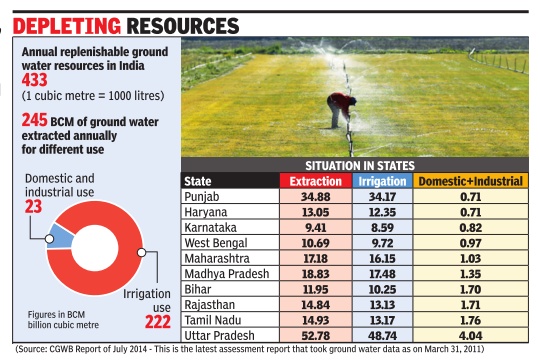
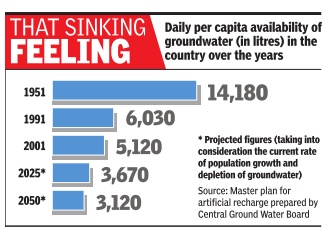
Chittaranjan Tembhekar
Do not be surprised if the country is forced to import drinking water by 2050, thanks to the fast-depleting groundwater stock that is expected to reduce to 3,120 litres per day a person by then. Data shows that today-going by 2001 figures -the daily per capita groundwater availability in the country has come down to 5,120 litres, about 35% of the 14,180 litres in 1951. In 1991, it was less than half of the 1951 stock. And by 2025, it is projected that the daily per capita availability will be just 25% of the base year. And the figures from a Central Ground Water Board (CGWB) study warn of a reduction to 22% by 2050, going by the present rate of exploitation of groundwater.
The depleting water beneath your feet is an indication of vanishing rainwater harvesting with ponds, lakes and wells, poor awareness, and reduced green cover, say experts.
A CGWB master plan to artificially recharge groundwater said: “Rapid development and use of groundwater resources for varied purposes has contributed, though, in expansion of irrigated agriculture, overall economic development and in improving the quality of life in urban India, the groundwater, which is the source for more than 85 per cent of rural domestic water requirements, 50 per cent of urban water requirements and over 50 per cent of irrigation requirements of the country, is depleting fast .“
Going by the fastgrowing population and their increasing demands, the day may not be far when per person availability dips to the actual use.
Abuse of groundwater
The extent of the problem, state-wise
The Times of India, Apr 21 2016
Not only sugarcane states, others too abuse groundwater
Vishwa Mohan
Over 90% of the extracted groundwater in India is used for irrigation.Though this has never been a secret, the quantum of groundwater use in different states shows that the culprits are not only the sugarcane producing states like Maharashtra, Uttar Pradesh and Karnataka. The onus of abusing groundwater resources also lies with wheat, rice, maize and oilseeds producing states like Punjab and Haryana. Groundwater use pattern of these two states show they are extracting more water than can be replenished, driving home the urgent need for farmers to adopt efficient micro-irrigation systems like drip and sprinkler which can help conserve water.
The Cen tral Ground Water Board (CGWB) in its latest assessment report noted that though Punjab has only 20.32 Billion Cubic Meter (BCM) of annual groundwater availability , it extracts 34.88 BCM annually . Similarly, Haryana extracts 13.05 BCM as against the availability of only 9.79 BCM. Of this, Punjab uses 34.17 BCM for its irrigation needs, while Haryana uses 12.35 BCM of groundwater it extracts annually for the same purpose.
Referring to such indiscriminate use of groundwater, the Union water resources minister Uma Bharti on Wednesday expressed her concern that prosperous states like Haryana and Punjab have “abused“ groundwater over the years and now most of their blocks fall under `dark' zones or highly groundwater exploited areas.
“More than 70% of their blocks are falling under dark zones now. A state like Maharashtra had reported water deficit situations earlier as well. But Punjab and Haryana tell us a tragic story,“ Bharti said while addressing the `India Water Forum', organised here by The Energy and Resources Institute, on the ongoing water crisis.
Though the situation of groundwater use is more or less same in many states, Punjab, Haryana and Rajasthan are especially guilty because of the excessive pumping causing severe groundwater depletion.
What's the way forward?
Sudhir Panwar, Lucknow Uni versity professor and president of the Kisan Jagriti Manch, said government policy should be tweaked in such a way that farmers could conveniently move towards sprinkler and drip irrigation systems the twin methods of using water in most judicious way in agriculture.
Delhi, Rajasthan, Haryana: extraction rises
The Times of India, Apr 17 2016
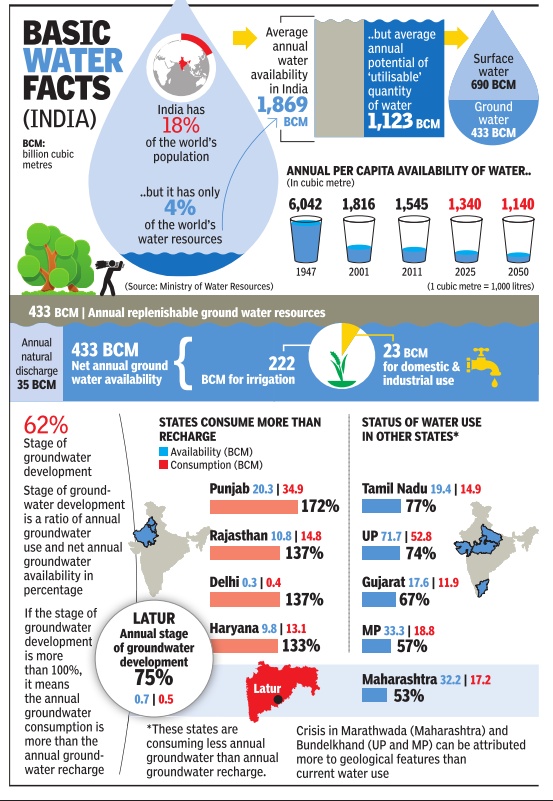
Vishwa Mohan
Delhi, Rajasthan, Haryana going the Latur way as groundwater extraction rises
Per Capita Availability Declining
As water trains and tankers help battle Latur's worst drought ever, rampant extraction of groundwater could soon push Delhi, Punjab, Haryana and Rajasthan towards a similar harrowing shortage of water.
Analysis of water use by different states shows that a gradual decline in per capita availability could leave these states in the same precarious position as the Marathwada region of Maharashtra, which has faced two consecutive years of drought.
The latest assessment of the country's dy namic groundwa ter resources, performed by Central Ground Water Board (CGWB), shows that these states, in fact, consume much more groundwater than their rechargeable limit every year, making them vulnerable to severe water scarcity.
Delhi recently witnessed how perilous the situation can get when agitating Jats cut off its water supply from Haryana. It could get much worse in the future if one looks at the way Delhi, Haryana, Punjab and Rajasthan have been drawing water from the ground.
Referring to the situation in Punjab and Haryana, former CGWB scientist Shashank Shekhar said, “Indiscriminate use of water in agriculture is a major concern. The practice of provid ing free electricity to farmers must be immediately discontinued to stop the misuse of groundwater in Punjab.“
“Since agriculture consumes the maximum water across the country , the use of drip irrigation and sprinklers must be encouraged through various incentives,“ he added.
Though the record of Maharashtra is better than its northern counterparts in terms of groundwater extraction, Latur district had been extracting more than the state average and now it does not have water to draw from existing borewells.
“There is need to drill a number of borewells in Latur with the help of geological data and remote sensing maps on prevailing hydrological information,“ said Shekhar, currently an assistant professor in Delhi University's geology department. “Many of them may fail to trace water.But there are chances that a few of them will tap the water bearing rocks,“ he added.
Though the exact estimate of groundwater resources can only be made after completion of the ongoing exercise of aquifer (underground layer of water-bearing rock) mapping, the Centre is, meanwhile, looking at various options to conserve water in a big way.One option is to introduce the tank-based water conservation model practised by the 11th century Kakatiya dynasty in Warangal area.
Under the Kakatiya dynasty, the then kings had promoted a small tank-based irrigation system which turned out to be a prudent method. Inter-connected rain-fed tanks were built to store rainwater. The Telangana government has, in fact, already launched `Mission Kakatiya' that aims to de-silt the existing tanks and build more such tanks to conserve water.
Arsenic in groundwater
Mohua Chatterjee, December 12, 2014
The parliamentary estimates committee headed by BJP MP Murli Manohar Joshi, in its first report on arsenic in groundwater, has criticized the Centre for “neglecting“ the serious issue that impacts at least 7 crore people across six states, according to CSIR estimates (data from different ministries and departments on the subject varies widely , the committee found). The panel has recommended that the Centre take up the issue on war footing through a national task force that can work on mission-mode from collating date to taking remedial measures to providing for health care to affected people. The committee has suggested that the issue be dealt with at the central level, instead of asking states alone to tackle the problem. Joshi said, “To say water is a state is sue is no logic, given the scale of the problem, the Centre cannot escape its responsibility to provide safe drinking water for 7 crore people, which is their fundamental right.” He was speaking at a press conference after the report was tabled.
The report has recommended that a national task force be set up on a time-bound basis that will work on mission mode on the issue that affects people, plants, animals and all else around it. The committee has also recommended for a central fund allocation for the purpose. At a press conference, Joshi said, the Centre cannot escape its responsibility to provide safe, potable water to 7 crore Indians which is there fundamental right.
India and the world
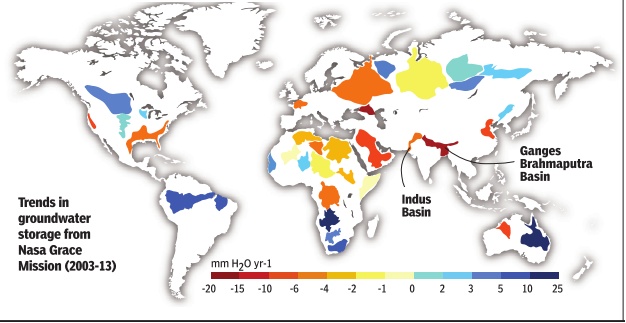
About 13 of the world's 37 biggest aquifers, including two in India, are being seriously depleted by irrigation and other uses, much faster than they can be recharged by rain or runoff. There were 21 major groundwater basins -in red, orange, and yellow -that lost water faster than they could be recharged between 2003 and 2013.Sixteen major aquifers (in blue) by contrast, gained water during that period.
March 2016
The Times of India, Mar 7, 2016, Mar 07 2016
Anand Bodh
Sharp drop in groundwater level in HP
Climate change has started ringing alarm bells in Himachal Pradesh as not only rain and snow pattern has been affected, but now groundwater level too has decreased significantly. The groundwater resources occur mainly in unconsolidated sediments of inter-mountain valleys and sub-mountain tract.Kangra, Una, Hamirpur, Bilaspur, Mandi, Solan and Sirmaur districts, particularly valley areas, depend on groundwater for their needs. Sarkaghat BJP MLA Inder Singh had asked a question during the ongoing budget session about the decreasing groundwater level in the state.He had also sought details of surveys conducted by the irrigation and public health department on the issue, besides steps taken by the department in this regard.
In a written reply, irrigation and public health minister Vidya Stokes informed the house that in many valleys and areas of the state declining trend of groundwater level had been found. She added that the de partment along with Central Groundwater Board had carried dynamic groundwater resource estimation.
To prevent the declining ground water level, the state government has approved detailed project report of about `139 crore to construct 956 rain water conservation structures, she said, adding that already 562 rain water conservation structures have been constructed at a cost of about ` 25 crore.
A report prepared by the Central Ground Water Board has stated that due to extensive groundwater useage for irrigation and the recently set up industrial units in Una valley, the levels are likely to further show depleting trend. There is an urgent need for the state government to initiate water level monitoring network both in shallow and deep aquifers to monitor its behavior on short as well as long term basis, it added.
Studies state that as on March 2011, the stage of groundwater development in Una and Hum valleys of the district was 108% and 99%, respectively, and falls under critical category of development.
There is, thus, no scope for further ground water development by constructing additional wells and tube wells in the area.
Another report on Solan district by Central Ground Water Board said that in many parts availability of water during summer is limited, particularly in hilly areas during drought low rain fall years. There is thus, immediate need to conserve and augment water resources.
It said that presently, large development of ground water is observed in industrial belts of Nalagarh valley, wherein fall of water level down to six meters have been observed in parts.
Thus, depletion in ground water levels and also vulnerability to ground water pollution, are the major issues in this industrial belt.
Report said that in alluvial areas of Nalagarh valley, though there is scope for ground water development, as stage of ground water development is only 52%, however, there is need to adopt cautious approach and phased manner development of ground water in view of depleting water levels in some parts.
This decline can be attributed to fast pace of development in recent years, both in agriculture sector and industrial sector.
See also
Groundwater: India
